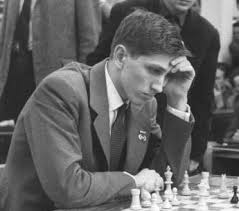Robert James Fischer (9 March 1943 - 17 January 2008)

World Champion between 1972 and 1975, Robert (Bobby) Fischer is arguably the most widely known chess player of all time. Together with Steinitz, Fischer's genius has often been overshadowed by controversies off the board. Fischer has raised chess to unprecedented popularity, as well as having substantially improved the conditions for professional players. Thousands have taken up chess as a result of Fischer's successes. He was born in Chicago and spent his formative years in different US cities until finally settling in Brooklyn. His parents separated when Fischer was a kid and his mother was his greatest influence on his life until she left the USA when Fischer was seventeen.
Fischer was taught the rules of chess by his sister when he was six. His mother took him to a simultaneous exhibition given by Max Pavey two years later. Fischer began playing religiously, up to six hours a day. Fischer was mostly influenced by Capablanca, but he also concentrated on modern openings and the King's Indian Defence and Najdorf Variation of the Sicilian Defence were his specialties.
After fifteen tournaments spanning two years, Fischer won his first major title, the
US Open Championship, in 1957. He followed this by placing first in the
US Closed Championship before his fifteenth birthday. His shared fifth in the
1958 Portoroz Interzonal made him the youngest grandmaster in FIDE history at the time.
At sixteen, Fischer dropped out of secondary school and became a professional player. Though he won seven US Championships convincingly, he experienced early setbacks abroad - for example, =13th at
Buenos Aires 1960 and fourth at Curacao 1962. However, winning the
1962 Stockholm Interzonal, and placing second in
Bled 1961 established him as a World Title contender.
Fischer boycotted the 1964/5 championship cycle and left the Sousse 1967 Interzonal in disputes with FIDE and tournament officials. Due to his conflict with the US Chess Federation, he was out of the 1969 Zonal, but was advanced to the
1970 Palma de Mallorca Interzonal when Benko withdrew in his favour. Here, his performance was astounding. Despite the strength of the field, he crushed his opponents and finished in first place with 18.5 points, a full 3.5 points ahead of his nearest rivals, Geller, Huebner and Larsen.
Even more impressive was Fischer's progress through the Candidates matches in 1971. In the
quarter-final he beat the Soviet grandmaster, Mark Taimanov, by 6-0 and repeated this score by a victory over
Larsen in the semi-final. The former World Champion, Petrosian, put up a tougher fight
in the final but he too was outplayed by the score of 6.5-2.5.
Despite inital and continuous controversy by Fischer regarding the playing conditions, including an actual withdrawal in Game 2, the
1972 Reykjavik match with Spassky went on. In the end Fischer proved his clear supremacy and by beating Spassky 12.5-8.5, he became the first US player to win the World Championship.
In the heat of the moment he promised to participate in many chess events. But as time passed he became increasingly reluctant to play and during his three-year reign as World Champion he did not play a single game in a chess tournament.
Fischer was also dissatisfied with the regulations for the match between himself and the next challenger. It became apparent that Fischer was not prepared to defend his title unless FIDE agreed with all the demanding changes he requested. He forfeited the title by refusing to play Anatoly Karpov in 1975.
Fischer resurfaced to play Spassky after twenty years in isolation, in 1992. This match occurred in Sveti Stefan and Belgrade, Yugoslavia, despite a United Nations embargo that included sanctions on commercial activities. Fischer insisted that the organisers billed the match as
The World Chess Championship, although Garry Kasparov was the official FIDE World Champion at the time. The prize fund for this rematch was US$5 million, with $3.35 million going to the winner. Fischer
won the match with 10 wins, 5 losses, and 15 draws.
Fischer lived most of his remaining life as a fugitive. He lived in Budapest, Hungary and allegedly had a relationship with the young Hungarian chess master Zita Rajcsányi. Fischer tried to promote his version of chess, Chess960. He visited the Polgar family in Budapest and analysed many games with the three sisters. Between 2000 and 2002, Fischer lived in Baguio City in the Philippines. He also lived for a time in Japan. On 13th July 2004, he was arrested by Japanese Immigration when he allegedly used a revoked US passport while trying to board a Japan Airlines flight. Fischer was eventually granted asylum in Iceland, the country he had put on the chess map.
On January 17, 2008, Fischer died from renal failure at the Landspítali Hospital in Reykjavík. His chess legacy will endure as long as chess is played.